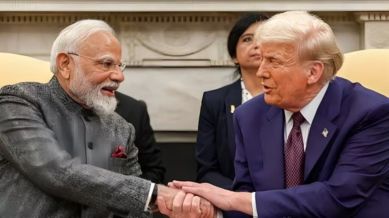US Secretary of the Treasury Scott Bessent, in a TV interview on Tuesday dubbed China’s new export controls on critical minerals as ‘China versus the rest of the world’, stating that the US is pushing back firmly and expects strong support from “Europe, India, and other Asian democracies”.
Bessent’s remarks could hint at an underlying American strategy to ring-fence Chinese trade dominance with the help of its allies, and that despite recent trade tensions with India, Washington still regards New Delhi as a strategic and economic partner — a stance underscored by the renewed escalation of the trade war with China.
As Indian negotiators head to Washington this week, shared concerns over critical minerals could provide the much-needed political push for the trade deal that has remained stalled for months. While high tariffs on Indian products have begun to hurt Indian MSMEs, the White House has also faced sharp criticism for pushing India towards the China camp.
Prime Minister Narendra Modi’s phone call with US President Donald Trump, along with the visit by newly appointed US Ambassador-designate Sergio Gor meeting with Commerce Secretary Rajesh Agrawal over the weekend, has also built fresh momentum for a long-awaited agreement. India has signalled its willingness to step up energy imports from the US to address the additional tariffs for imports of Russian oil.
Ajay Srivastava, former trade officer and head of think tank Global Trade Research Institute (GTRI), said the US now seems ready for a trade deal with India, as China’s tighter control over rare-earth exports and a deepening US–China trade war are forcing Washington to rethink its strategy with allies in search of reliable partners to build alternative supply chains.
“This could accelerate a trade deal with India, with the US likely offering 16–18 per cent tariff access — higher than the 15 per cent for the EU and Japan but below the 20 per cent for Vietnam. The deal may move quickly because Washington wants it, giving India relief from the 50 per cent tariffs currently hurting its exports. Still, India must hold firm on its red lines in agriculture, digital trade, e-commerce, and intellectual property, and avoid any anti-China clauses that could limit its strategic autonomy,” Srivastava said.
India-US critical mineral dynamics
A report by the Centre for Social and Economic Progress (CSEP) said that out of the 50 critical minerals identified by the US, 40 overlap with India’s list of critical minerals.
Story continues below this ad
“There is an 80 per cent overlap between minerals identified by both countries, showcasing potential for cooperation, especially in third geographies such as Africa. Many of the minerals identified are Platinum Group Metals or Rare Earth Elements (REEs), which are geographically located in Africa,” the report said.
The report said that India also has deposits of various REEs, such as thorium and light REEs such as neodymium, praseodymium, dysprosium, and terbium. International collaborations, such as the one between Indian Rare Earth Limited (IREL) and Toyotsu Rare Earth India Limited (a subsidiary of Toyota Tsusho Corporation, Japan), hold significant potential for India and the US to strengthen collaboration for mutual benefit.
However, CSEP said one key obstacle is the differing approaches between the two countries. While the US prioritises extraction and mining, India focuses on research, recycling, and sustainable alternatives due to its limited domestic reserves. These differences could require careful coordination to ensure mutually beneficial outcomes.
China’s dominance in the global critical minerals market, which has created a wide gap in price point between Chinese products and those produced elsewhere, is a shared challenge. While this could help India attract American investments, it could also expose India to coercion by China over its deepening involvement with the US.
Story continues below this ad
The report said that regulatory and environmental concerns present hurdles. The US has stringent environmental laws that can slow down mining and processing projects, while India must balance industrial expansion with its climate commitments and domestic socio-environmental concerns.
Risks from a US-China grand bargain
Experts have pointed out that China’s curbs on critical minerals, such as licensing requirements, could be a deliberate plan to use as a negotiating chip, as the impact of the curbs would depend on how Beijing enforces the regulations announced on October 9.
While the US has criticised China’s actions, it has also expanded the use of Section 232, adding more products to the list of curbs, which could give the Trump administration stronger legal cover ahead of the 5 November Supreme Court case where small MSMEs have challenged Trump’s use of emergency powers to impose reciprocal tariffs.
Beyond tariffs, tensions between the US and China are expanding into other areas. The US has imposed a $50 per net ton fee for Chinese-owned or -operated vessels docking at American ports, with plans to increase the fee by $30 annually until 2028. In retaliation, China imposed sanctions on five US-based subsidiaries of South Korean shipbuilders and announced plans to charge US-owned or -operated vessels a fee upon entry to Chinese ports.
Story continues below this ad
Experts said this trade posturing could be related to negotiations between the two countries ahead of a likely meeting between Trump and Chinese President Xi Jinping during the Asia-Pacific Economic Cooperation (APEC) summit in late October. A China-US grand bargain before an India-US trade deal could be a risk for India, as Beijing has said it will respond to a trade deal at its expense.
